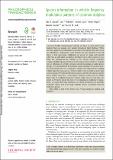Files in this item
Species information in whistle frequency modulation patterns of common dolphins
Item metadata
| dc.contributor.author | Oswald, Julie Nicola | |
| dc.contributor.author | Walmsley, Sam | |
| dc.contributor.author | Casey, Caroline | |
| dc.contributor.author | Fregosi, Selene | |
| dc.contributor.author | Southall, Brandon | |
| dc.contributor.author | Janik, Vincent M. | |
| dc.date.accessioned | 2021-09-07T09:30:03Z | |
| dc.date.available | 2021-09-07T09:30:03Z | |
| dc.date.issued | 2021-10-25 | |
| dc.identifier | 274006357 | |
| dc.identifier | 561d8178-df37-4b5d-9108-8e69a494f6d5 | |
| dc.identifier | 000693558500010 | |
| dc.identifier | 85115819542 | |
| dc.identifier.citation | Oswald , J N , Walmsley , S , Casey , C , Fregosi , S , Southall , B & Janik , V M 2021 , ' Species information in whistle frequency modulation patterns of common dolphins ' , Philosophical Transactions of the Royal Society. B, Biological Sciences , vol. 376 , no. 1836 , 20210046 . https://doi.org/10.1098/rstb.2021.0046 | en |
| dc.identifier.issn | 0962-8436 | |
| dc.identifier.other | ORCID: /0000-0001-7894-0121/work/99804401 | |
| dc.identifier.other | ORCID: /0000-0002-1524-9592/work/99804703 | |
| dc.identifier.uri | https://hdl.handle.net/10023/23909 | |
| dc.description | Funding for this project was generously provided by the Office of Naval Research Marine Mammals and Biology program. | en |
| dc.description.abstract | The most flexible communication systems are those of open-ended vocal learners that can acquire new signals throughout their lifetimes. While acoustic signals carry information in general voice features that affect all of an individual's vocalizations, vocal learners can also introduce novel call types to their repertoires. Delphinids are known for using such learned call types in individual recognition, but their role in other contexts is less clear. We investigated the whistles of two closely related, sympatric common dolphin species, Delphinus delphis and Delphinus bairdii, to evaluate species differences in whistle contours. Acoustic recordings of single-species groups were obtained from the Southern California Bight. We used an unsupervised neural network to categorize whistles and compared the resulting whistle types between species. Of the whistle types recorded in more than one encounter, 169 were shared between species and 60 were species-specific (32 D. delphis types, 28 D. bairdii types). Delphinus delphis used 15 whistle types with an oscillatory frequency contour while only one such type was found in D. bairdii. Given the role of vocal learning in delphinid vocalizations, we argue that these differences in whistle production are probably culturally driven and could help facilitate species recognition between Delphinus species. | |
| dc.format.extent | 9 | |
| dc.format.extent | 930140 | |
| dc.language.iso | eng | |
| dc.relation.ispartof | Philosophical Transactions of the Royal Society. B, Biological Sciences | en |
| dc.subject | Delphinus delphis | en |
| dc.subject | Whistles | en |
| dc.subject | Common dolphin | en |
| dc.subject | Vocal learning | en |
| dc.subject | Species recognition | en |
| dc.subject | Delphinus bairdii | en |
| dc.subject | QH301 Biology | en |
| dc.subject | QL Zoology | en |
| dc.subject | DAS | en |
| dc.subject.lcc | QH301 | en |
| dc.subject.lcc | QL | en |
| dc.title | Species information in whistle frequency modulation patterns of common dolphins | en |
| dc.type | Journal article | en |
| dc.contributor.institution | University of St Andrews. Scottish Oceans Institute | en |
| dc.contributor.institution | University of St Andrews. School of Biology | en |
| dc.contributor.institution | University of St Andrews. Sea Mammal Research Unit | en |
| dc.contributor.institution | University of St Andrews. Marine Alliance for Science & Technology Scotland | en |
| dc.contributor.institution | University of St Andrews. Institute of Behavioural and Neural Sciences | en |
| dc.contributor.institution | University of St Andrews. Centre for Social Learning & Cognitive Evolution | en |
| dc.contributor.institution | University of St Andrews. Bioacoustics group | en |
| dc.identifier.doi | 10.1098/rstb.2021.0046 | |
| dc.description.status | Peer reviewed | en |
This item appears in the following Collection(s)
Items in the St Andrews Research Repository are protected by copyright, with all rights reserved, unless otherwise indicated.

